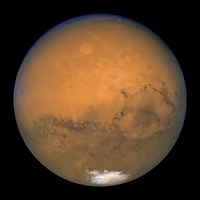Mars
 |
Origin of name
Naming convention
ESA Mission |
Mars Express
Mars Express, so called because of the rapid and streamlined development time, represents ESA's first visit to another planet in the Solar System. Borrowing technology from the Mars 96 mission and ESA's Rosetta mission, Mars Express is helping to answer fundamental questions about the geology, atmosphere, surface environment, history of water and potential for life on Mars.
Physical Properties
| Property | Unit | Value | Earth = 1 |
| Equatorial radius | km | 3397 | 0.533 |
| Polar radius | km | 3375 | 0.531 |
| Core radius | km | 1700 | 0.488 |
| Flattening | 0.00648 | 1.934 | |
| Mass (x1024) | kg | 0.64185 | 0.107 |
| Volume (x1010) | km3 | 16.318 | 0.151 |
| Mean density | kgm-3 | 3933 | 0.713 |
| Surface gravity at equator | ms-2 | 3.71 | 0.379 |
| Escape velocity | kms-1 | 5.03 | 0.450 |
| Magnetic dipole field at equator | T | < 10-8 | |
| Number of natural satellites | 2 |
Orbital Parameters
| Property | Unit | Value |
| Perihelion (x106) | km | 206.62 |
| Aphelion (x106) | km | 249.23 |
| Mean distance from the Sun (x106) | km | 227.92 |
| Mean distance from the Sun | AU | 1.524 |
| Eccentricity | 0.0935 | |
| Sidereal orbit period | d | 686.980 |
| Sidereal rotation period | h | 24.6229 |
| Length of day | h | 24.6597 |
| Orbit inclination to Eliptic | ° | 1.850 |
| Mean orbital velocity | kms-1 | 24.13 |
| Maximum orbital velocity | kms-1 | 26.50 |
| Minimum orbital velocity | kms-1 | 21.97 |
| Axial tilt | ° | 25.19 |
Notes
-
Sidereal orbit period
The time taken by the planet to complete exactly one orbit around the Sun with respect to the celestial sphere. -
Sidereal rotation period
The time in which the planet rotates around its axis exactly 360° with respect to the celestial sphere. -
Length of a day
Defined as the time between two successive sunrises over the meridian. -
Magnetic dipole moment
Calculated as the ratio of the magnetic field strength at the equator divided by the cube of the equatorial radius.
Last Update: 1 September 2019
